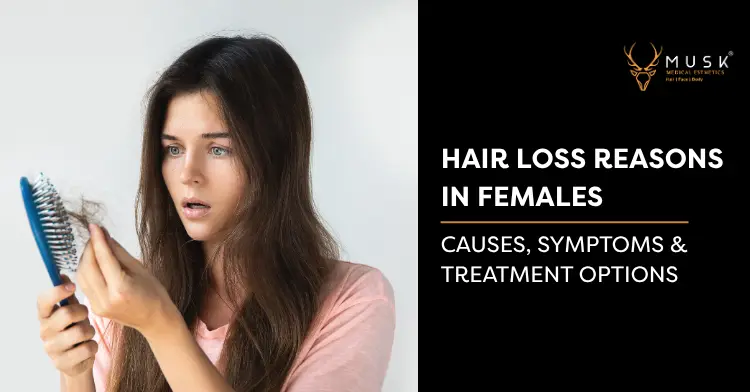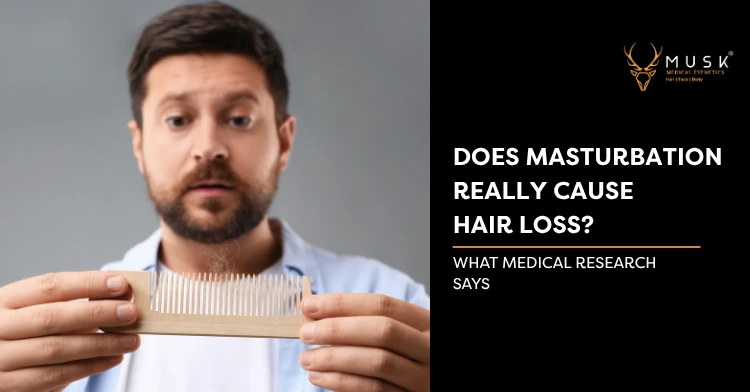Female Pattern Baldness: Symptoms, Causes, Stages, and Treatments

Female pattern baldness also known as female pattern hair loss or androgenetic alopecia, is a common condition that affects millions of women worldwide. While it’s also associated with men, women can also experience hair thinning and loss that follows a distinct pattern. The impact of female pattern baldness extends beyond just physical appearance, as it can have significant emotional and psychological effects on women.
In women, this form of hair loss is associated with an increased risk of polycystic ovary syndrome(PCOS), characterized by a hormonal imbalance that can result in irregular menstruation, acne, excess hair elsewhere on the body(hirsutism), and weight gain.
In this blog, you will get the in-depth insights of Female Pattern Baldness along with its symptoms, its causes, different stages of female baldness, and how to treat it.
Introduction to Female Pattern Baldness
We often have recognized the concern of hair loss and hair thinning in women, which develops gradually and results in complete or partial hair loss. This practice of losing hair is known as Female Pattern Baldness, often referred to as Alopecia without the presence of Androgen and Androgenetic Alopecia with the presence of Androgen in medical language. It’s by far the most common type of hair loss, and the condition is responsible for more than 50% of women in India.
This type of hair loss is largely due to genetics and more common with age. Your hair follicles are more sensitive to the effects of dihydrotestosterone(DHT), a derivative of testosterone. As a result, hair follicles begin to shrink, miniaturize, and lead to thinning.
As heard from doctors, this pattern in every individual differs and it is not defined how much of loss an individual can have. Research shows that it has also been linked with depression and anxiety in women.
All around, hair loss can affect your personal as well as professional life. That is why we want to help you out with each aspect of Female Pattern Baldness.
What are the Symptoms of Female Pattern Baldness?
Female-pattern baldness typically starts with scalp hairs becoming progressively less dense. Many women first experience hair thinning and hair loss where they part their hair and on the top-central portion of the head.
In order to identify the Female pattern Baldness, below mentioned are the most common Female Pattern Baldness Symptoms.
In Female Pattern Baldness;
- Gradual thinning on top of head
- Hair loss around your center part
- Circular or patchy bald spots
- Sudden loosening of hair
Female Pattern baldness usually starts after Menopause. In the earlier stage, hair loss starts to appear near the center part. Later, it’ll start affecting your hair on either side and toward the front of your scalp.
What Causes it?
Women tend to lose hair thickening and amount as they age. This type of baldness is not usually caused by a disease. It is related to age, heredity, and changes in the hormone testosterone.
Although, the reason for hair loss in women is not well understood by all but in our opinion, it is related to;
- Aging
- Changes in the levels of Androgens(Hormones)
- Family history of Female Pattern Baldness
- Heavy loss of blood during menstrual periods
- Severe emotional stress
- Certain medicines, such as estrogenic oral contraceptive
Any individual may happen to have Female Pattern Baldness caused by any of these reasons. Causes may differ from one to another, but the common symptoms of it helps to identify the pattern.
Three Stages of Female Pattern Baldness
Female pattern Baldness tends to progress in a similar way for all women. It is typically characterized by three distinct stages.
Stage1: Hair Thinning
This is the earlier stage of Female Pattern Baldness, where hair starts thinning on the top of the head and then around the parting area. This stage is often unnoticed as it can be concealed with certain hair styles.
Stage2: Visibility of Scalp
In this middle stage of Female Pattern Baldness, the scalp starts to become visible through hair as hair loss progresses. At this stage of Female Pattern Baldness, women happen to seem concerned about their hair loss, because the parting is noticeably wider than in women who don’t have significant hair loss.
Stage3: Advanced hair Loss
This is the later stage of Female Pattern baldness, where women face the advanced hair loss resulting in partial or complete baldness. The person may be fully bald in the areas affected by Female Pattern Baldness. Women tend to consider medical treatments in this stage of hair loss.
How to treat Female Pattern Baldness?
Hair loss is the most common problem in women, but thankfully it is preventable and reversible with certain medical treatments. Although, without treatment Female Pattern Baldness is permanent.
Here are some of the most popular treatments for Female Pattern Baldness:
-
Medications:
Medications are the most common treatments for hair loss in women. Minoxidil is one of the most successful hair loss prevention drugs in the market to stimulate hair growth. This topical solution is applied to the scalp, increasing blood flow to the hair follicles. It’s proven to reduce hair loss in people experiencing Female Pattern Baldness. While Minoxidil is a successful solution to hair loss, it’s been known to cause excessive hair on the face/body.
-
Hair Transplant:
If your hair loss is advanced, then hair transplant may be the best solution to it. Modern hair transplant methods are safe, and successful – gives you natural looking hair. It is the best hair restoration option for those who are facing advanced hair loss with bald patches on their head. It leaves no scarring and has a faster recovery.
-
Anti-androgens:
Anti-androgen treatments can accelerate the hair growth in women. Treatments such as spironolactone, cyproterone, Finasteride, and Dutasteride — can reduce female pattern hair loss symptoms. Some anti-androgen treatments, like Finasteride and Dutasteride, aren’t recommended for women. So it’s a good idea to discuss any treatment plan with a doctor or qualified hair loss specialist before taking an anti-androgen drug.
Unlike the above treatments, few other habits can help in reducing hair loss. Speaking of those, a change in lifestyle is one of them. Adopting a healthy lifestyle won’t stop female hair pattern baldness developing altogether but may slow the rate of hair loss. Limiting sunlight exposure, eating a healthy diet, and taking vitamin supplements to lower the deficiency of iron and zinc – all these may help.
Be Confident!
Female Pattern Baldness is usually not a sign of an underlying medical disorder. Hair loss may affect self-esteem and cause anxiety, as it is permanent without the treatment.
At Musk Clinic, we provide you with the treatments for your hair loss and help you to stand out with confidence again.
Book your consultant call with us today.
Read More:
6 ESSENTIAL TIPS FOR SUMMER HAIR CARE
BENEFITS OF PRP TREATMENT FOR HAIR LOSS: WHAT YOU NEED TO KNOW
HAIR LOSS PREVENTION SECRETS: THE DO’S AND DON’TS YOU NEED TO KNOW FOR HEALTHY HAIR











